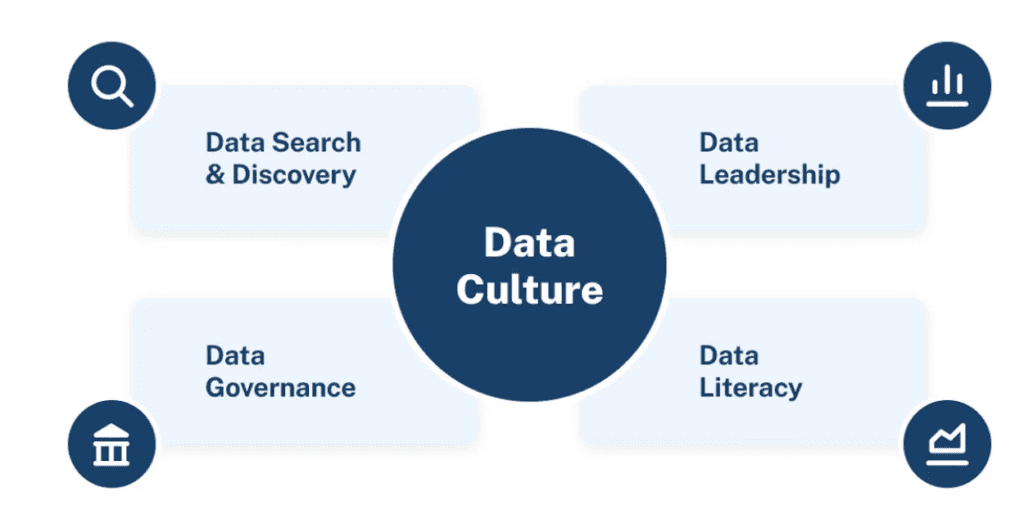Beyond Models: Unlocking AI Through Data Maturity

Introduction
In 1992, James Carville, a strategist for Bill Clinton’s presidential campaign, coined the phrase “It’s the economy, stupid.” That was 32 years ago. Today, as organizations continue to understand and experiment with predictive and generative AI models, they often become enamored with which model to use when. Selecting the appropriate models is certainly an important task, but it’s not the ultimate game-changer for organizations.
What truly sets organizations apart in the era of predictive and generative AI technology? The answer lies in the organization’s data maturity and its culture. Research presented at the MIT Chief Data Officer and Information Quality Symposium showed that data-mature companies “enjoy increased revenue, improved customer service, best-in-class operating efficiencies, and improved profitability.”[1]
However, becoming a data-mature organization will not happen overnight, nor will it happen by accident. It requires a comprehensive, organization-wide approach focused on four key pillars: data leadership, data search & discovery, data literacy, and data governance.[2]

Lufthansa, for example, recognized the importance of developing data leaders across the organization to drive its data-driven transformation. The airline created a program to educate leaders at all levels and turn data into accelerated change.[3]
This article will dive deeper into the four pillars of data maturity, examine the different types of data leaders organizations need, and provide practical advice on improving data maturity. We’ll also introduce the Alation Data Culture Maturity Model as a framework for benchmarking and advancing data management capabilities.
Analogous to Carville’s advice to focus on the economy, by focusing on Data Maturity and Leadership, you will create a competitive advantage that will help you maintain or create a competitive advantage.
The 4 Pillars of Data Maturity
Becoming a data-driven organization requires focusing on four key pillars: data leadership, data search & discovery, data literacy, and data governance. Let’s explore each of these critical areas in more depth.
1. Data Leadership
Effective data leadership is essential for driving data maturity. It starts at the top, with vocal executive sponsorship, a robust change management program, a straightforward onboarding process, and a relentless focus on business value and ROI.
Leaders at all levels must champion the value of data, act as role models in data-driven decision-making, and drive the required cultural shift. As Thomas Rückert, CIO of Lufthansa Group, put it: “The right awareness of data-specific skills among all leadership levels creates the necessary tension to successfully drive the transformation toward a data-driven [organization].”[4]
2. Data Search & Discovery
Making data findable and usable across the organization is critical to enabling data-driven decision-making. A data catalog plays a key role here by providing a single access point to data assets, along with curated context and insights via metadata.
Empowering data stewards as subject matter experts is also crucial. These power users can add vital business context to data assets, democratizing tribal knowledge. Partnering with them early can create valuable momentum for your data enablement efforts.
3. Data Literacy
Improving data literacy is a critical change management effort that underpins data maturity. Key components include training programs tailored to different personas and roles, vibrant user communities, targeted skills assessments, and individualized learning journeys.
Infrastructure is important, too. Look for tools that support data literacy, such as business glossaries to align key terms, intelligent SQL editors to guide analysis, and wiki-like articles to capture and share knowledge.
4. Data Governance
The foundation for data maturity requires a robust data governance framework with documented policies and clear accountability. An effective governance program supports regulatory compliance, data quality, and trust in data assets.
A data catalog enables governance by providing visibility into data lineage, usage, and access controls. Automated policy enforcement and impact analysis help ensure policies are followed, and risks are managed.
Focusing on these four interconnected pillars can help organizations advance their data maturity and become more data-driven. Assessing capabilities across these dimensions provides a roadmap for the journey ahead.
The 6 Roles of Effective Data Leaders
In the MIT Sloan Management review article, How Lufthansa Shapes Data-Driven Transformation Leaders, Lufthansa recognized that developing effective data leaders was critical to its transformation initiatives. They defined six different leadership roles that spanned both technical and business functions.
1. Data Visionary
Lufthansa’s top leaders, including the CEO, played the critical role of data visionary – defining the overarching organizational vision for data and AI and emphasizing its importance. “Top managers are also important data decision makers and must act as role models in showing employees how data benefits decision-making.”[5]
2. Data Transformer
The Chief Data Officer (CDO) serves as a data transformer, providing thought leadership and setting up organizational and technical transformation programs. “The CDO crafts this ideal picture in collaboration with other top management.”[6]
3. Data Driver
Technical leaders like principal data scientists are “much more engaged in playing the role of data driver”[7] – understanding business value, designing use cases, and nurturing efficient data use.
4. Data Collaborator
Business leaders play a vital role as data collaborators, breaking down silos and connecting the right people across the organization. “These leaders must tighten the loose ends in data-sharing efforts, help break down data silos, and connect the right people across boundaries within the business to support specific implementations.”[8]
5. Data Coach
Business leaders also serve as data coaches, motivating individuals to continuously learn and improve their data and AI skills. “When acting as data coaches, these leaders must motivate individuals to practice continuous learning with data and AI, empower them to learn new skills, and accompany them on their individual development journeys.”[9]
6. Data Owner/Curator
Product owners and similar business stakeholders play the critical role of data owners and curators, who are responsible for understanding the business value of data assets and ensuring they are fit for use.[10]
So, what leadership development programs did they implement? The airline created a three-part training program to develop leaders who could fulfill these key roles: Spark, Inspire, and Activate.
- “The Spark module teaches that data drives business, aiming to train leaders to understand the power and limits of data and AI, drive use cases to build business value, and glance into the future by understanding data and AI megatrends.”[11]
- “The Inspire module teaches that stories drive use cases. It trains leaders to show the North Star when building a data strategy and vision, tell inspiring and high-impact data stories, and build an internal network to rally people around the data mission.[12]
- “The Activate module teaches leaders that they drive transformation. It helps them learn the characteristics of an effective data leader, build a data culture by investing in people and avoiding toxicity, and handle trials and triumphs as part of an experimental culture.”[13]
By focusing on developing leaders who could embody these critical roles and drive change, Lufthansa laid the foundation for its successful data-driven transformation.
Improve Data Literacy for Everyone, Not Just the Leaders
In the HBR article, Your Teams Should Drive AI Adoption — Not Senior Leadership, the authors emphasize that appointing a “czar” to AI projects is a mistake.[14] Why?
Appointing a senior leader to oversee AI adoption is often a mistake. While it may seem like the right move, these “czars” are typically too far removed from the frontlines where the work happens to effectively identify the best opportunities to apply AI. Instead, AI adoption should be driven by the teams closest to the workflows who deeply understand the processes and can spot the use cases that will deliver the most value.
The role of senior leadership in AI adoption is to provide a supportive foundation—a center of excellence that offers platforms, data engineering capabilities, and governance frameworks. But, the actual implementation should be owned by frontline teams that can bring their operational expertise to bear in applying AI responsibly at scale. Verizon provides a good example of this approach in action.
Empowering frontline teams to guide AI usage has delivered tangible results for Verizon. In customer service, an AI search tool has improved answer accuracy to be on par with human agents. In sales, proactive AI-driven personalization has increased conversion rates by over 6%.[15] The lesson is clear – companies need more than just an executive in charge for long-term success with AI. They need to harness the talent of frontline employees to create an operational edge, just as they did in the early internet era.
Practical Advice and Next Steps
Empower frontline teams to drive AI adoption and innovation
- Instead of appointing a senior “AI czar”, give ownership of AI implementation to the teams closest to the workflows who deeply understand the processes and can identify the best opportunities to apply AI.
- Support these frontline efforts with a center of excellence that provides platforms, data engineering, and governance frameworks.
- Measure progress and gather real-time feedback from the point of contact to continuously improve AI models and performance.
Develop data leaders at all levels of the organization
- Recognize that effective data leadership is needed beyond technical roles like the CDO. Business leaders must also champion data-driven transformation.
- Define clear data leadership roles such as data visionary, data transformer, data driver, data collaborator, data coach, and data owner/curator.
- Create targeted training programs to develop the skills needed for these data leadership roles, tailored to different leadership levels, from team leads to top executives.
Assess your organization’s data maturity and create a roadmap
- Use a framework like the Alation Data Culture Maturity Model to benchmark your current data management capabilities across data leadership, data search & discovery, data literacy, and data governance.
- Identify gaps and prioritize areas for improvement based on business goals.
- Develop a comprehensive strategy and roadmap to advance your data maturity, with executive sponsorship and clear metrics to measure progress.
Summary
Becoming a data-driven organization remains at the top of business leaders’ minds in the era of predictive and generative AI. As James Carville famously said about the economy back in 1992, today, it’s all about the data. However, advancing data maturity is not just a matter of selecting the right AI models. It requires a comprehensive, organization-wide effort focused on developing data leadership, literacy, search and discovery, and governance capabilities.
In the end, becoming data-driven is a challenging process. As Lufthansa CIO Thomas Rückert put it, “The right awareness of data-specific skills among all leadership levels creates the necessary tension to successfully drive the transformation toward a data-driven [organization].”[16] By focusing on the four data culture pillars, creating training programs, and empowering frontline teams to innovate with data, organizations can create a competitive moat. In the AI era, it’s not just the economy—it’s the data culture, stupid.
If you enjoyed this article, please like it, highlight interesting sections, and share comments. Consider following me on Medium and LinkedIn.
Please consider purchasing my latest TinyTechGuide:
- Generative AI Business Applications: An Exec Guide with Life Examples and Case Studies.
- The CIO’s Guide to Adopting Generative AI: Five Keys to Success,
If you’re interested in this topic, check out TinyTechGuides’ other books, Mastering the Modern Data Stack or Artificial Intelligence: An Executive Guide to Make AI Work for Your Business.
[1] Brown, Sara. 2020. “How to Build a Data-Driven Company.” MIT Sloan. September 24, 2020. https://mitsloan.mit.edu/ideas-made-to-matter/how-to-build-a-data-driven-company.
[2] “The Alation Data Culture Maturity Model | Alation.” n.d. Www.alation.com. Accessed May 5, 2024. https://www.alation.com/resource-center/whitepapers/alation-data-maturity-model/.
[3] Lagardère, Christian Haude, Ivo Blohm, and Xavier. 2024. “How Lufthansa Shapes Data-Driven Transformation Leaders.” MIT Sloan Management Review. April 18, 2024. https://sloanreview.mit.edu/article/how-lufthansa-shapes-data-driven-transformation-leaders/.
[4] Ibid.
[5] Ibid.
[6] Ibid.
[7] Ibid.
[8] Ibid.
[9] Ibid.
[10] Ibid.
[11] Ibid.
[12] Ibid.
[13] Ibid.
[14] Sampath, Sowmyanarayan. 2024. “Your Teams Should Drive AI Adoption — Not Senior Leadership.” Harvard Business Review. April 30, 2024. https://hbr.org/2024/04/your-teams-should-drive-ai-adoption-not-senior-leadership.
[15] Ibid.
[16] Lagardère, Christian Haude, Ivo Blohm, and Xavier. 2024. “How Lufthansa Shapes Data-Driven Transformation Leaders.” MIT Sloan Management Review. April 18, 2024. https://sloanreview.mit.edu/article/how-lufthansa-shapes-data-driven-transformation-leaders/.


